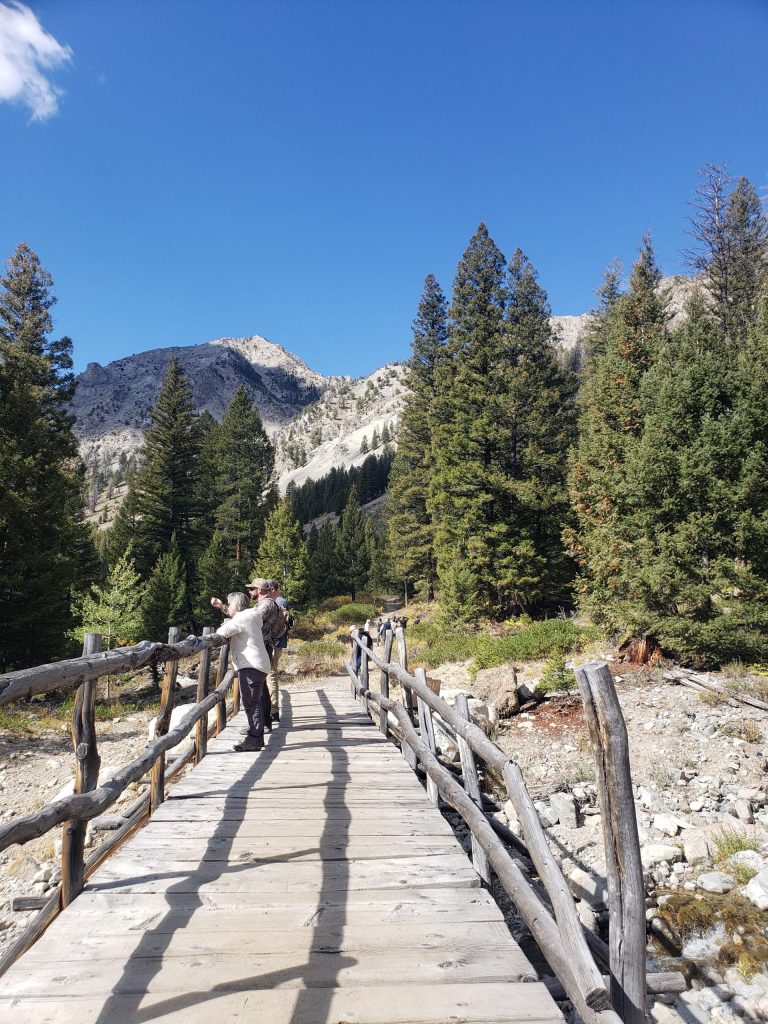
“Our new I-Vis technology provides wearers of ballistic eye protection the most accurate view of the world around them. I-Vis lenses increase the separation of colors so that when you’re wearing them, you’ll see multiple shades of a color compared to the single shade you’d see with the naked eye or when using traditional lens tints,” says Revision CEO Amy Coyne. “The result is greater awareness and faster reaction times. In a military setting, this translates into greater survivability and lethality.”
Revision has been a household name when it comes to Military and Law Enforcement Ballistic Eyewear. With a comprehensive NSN list it has been the main eye protection choice. Full List Here.
The information on I-Vis is going to be derived from attending the two day Revision Release Event for I-Vis held in Ketchum, Idaho. During this event we attended a briefing about the eyewear and the science/technology behind it. We then traveled about 20 minutes outside of town to a great high altitude hiking trail. Before the hike we did some identification of items hid within a small area, and then went on a professionally guided hike to spot mountain goats. The next day we did target shooting, both long range rifle and clay shooting with a professional eye doctor and expert clay shooter. Those who attended the events were mostly civilian with a small amount being prior military.

Quick Overview of I-Viz
Now, Revision has given us a complete set of technological advanced lens’s that are environment oriented, I-Vis. Prior to I-Vis, Revision gave us three main lens’s on the Stingerhawk frame, The clear, dark and yellow hue. Now we have six lens’s that are directly matched to the environment users are operating in. No, these lens’s aren’t changing the environment that we are looking at, they are simply enhancing details within it.
“More than a single solution, I-Vis lenses are available in six tints, each optimized for use in a different environment. With the power of artificial intelligence, Revision accounted for theater-specific color vision variables that take into account the color palette of locations while modeling the most likely lighting conditions to occur in that area using global data from the National Oceanic and Atmospheric Administration (NOAA).”-Revision

Food for thought: Next time you look at the newest release of eye pro on the shooter market, look at the color of the lens’s and how they interact with the environment. Do they change the color of the items? This will actually tire the brain out as items are being processed due to your brain thinking “that steel that is supposed to be white is now yellow” instead of “that white steel is still white just easier to be seen and more detailed.” There is a difference in lenses enhancing the environment or changing it. To do this, in simple terms, they used the color world instead of the well-known color wheel. The color wheel is a small portion of the colors that we see. When we look at the environment with our naked eye we see greens, browns, and reds. With I-Vis though we see multiple colors of those greens or reds. Revision went to that color world and found the slew of colors that are found in various environments, and created a lens that enhanced those specific colors.

The Lenses
Each lens is made with ancient Greek names to insinuate that type of environment that the lens is made for. For example, Alto meaning to raise, elevate. This lens is used for high altitude environments. So on so forth.
Note: The VLT rating noted in each lens photos stands for Visible Light Transmission. This is the amount of visible light that can pass through the lens. The lower the VLT, the darker the sun lens will be.
For instance, the Umbra has a higher percentage because it is meant to be used in a clouded snow environment, needing a lighter lens. The Clara showing a VLT of 12, lower than the Umbra, due to being used in a sunny environment and needing to shield some of that light out.






Practical Applications
With all of this talk about Military specific eyewear, let us not lose that these are made for civilian application. We are all “operating”” in specific environments. Whether that operation means shooting a match in the high desert, hunting in the dense woods, or finding bighorn sheep in the mountains of Idaho (we did this at the Revision media event). We as civilians deserve the same Ballistic eyewear that those running missions in the jungle are wearing.
Shooting a Match
Fun Fact: A cool thing about the technology behind these lens’s, the lens curve and design is actually made to appease a shooter using the top right or left corner of the lens but yet also the center. Think of when mounting a rifle, you are now looking through a different part of your eyewear. Working with a professional eye doctor, Revision designed the lens to work while looking through the middle of the lens and the side.
Field Match
A long range field match really lets this eyewear shine. While it is understood that many who shoot bolt gun or long range in general do not wear eye protection, this eyewear will only help, not hurt. A large part of field matches is spotting your target. Oftentimes in various disciplines such as NRLHunter matches of Competition Dynamics matches they will make the shooter spot and range their own target. Seeing details in a large area is huge in this discipline. Let’s say we are shooting in Grand Junction, Colorado (though we aren’t anymore due to their high capacity magazine law, but I digress) This environment is full of light browns and tans due to it encompassing a high desert feel. While our naked eye sees a lot of one color, the true color of the environment is actually made up of many of those tans, just like the color world we talked about earlier. To spot a steel white/gray/brown target within those tans and browns that detail of the target needs to stand out to your eye to find it and range it properly. The I-Vis Lens Aros would be the lens to choose for this environment.

Flat Range
Use on a flat range uses the same values as before. Find your target, keep your eyes safe, and don’t tire your brain or eyes out. While many glasses on the market for flat range pistol shooting is of a yellow tint that changes the color of targets, these lens’s don’t do that but still allow for the same protection and enhanced visualization. For flat range shooting say USPSA matches the lens Cano or Verso would work well. Remember though, all users see things differently, it’s on the shooter to really dial in which lens works best for THEM and in which environments.
If using a red dot, the lens will not impact the red dot but instead enhance it without bloom. So the red dot can be on it’s lowest setting and still be seen well due to the detail coming out.
Snow
To go with the flat range shooting lens type, remember that snow can alter the eye drastically whether it is sunny or cloudy. Revision I-Vis gives us two different lenses for this environment.
Personally, this is my favorite part of the I-Vis line up. The lenses Clara and Umbra are made for either sunny snow environments or cloudy snow environments. This can be applied both on a flat range when it is so sunny and the sun is reflecting off the snow that your eye will be stressed and need some shade and in a field match when everything looks the same. White snow, white targets. These lenses won’t darken everything but instead brings out contrast within the whites and blues.
Hunting/Tracking
One story that was brought up during our brief is the use of I-Vis while tracking. Many users have stated that they noticed moved dirt with the lens vs not. Remember these lens’s work to bring out the detail and colors that are already there, not create any. Dirt being moved will be colder than stagnant dirt or land. This can be used for noticing tire tracks as well.
Hunting is all about spotting animals in environments that these animals are meant to be hidden. Noticing detailed and differing colors instead of the same overall browns/tans/greens will help spot and track those animals.

Target Identification
During the Revision I-Viz event there was an exercise where we would put on the older Revision yellow tinted Stingerhawk glasses and find items hidden in a small area within the woods. Items such as green army men, blue bandanas, boonie hats, etc. The number of items that we found would be tracked. We then would put on the Cano Lens and spot the same items. For myself specifically I found about 5 more items with the Cano lens than with the yellow tinted. This is due to details coming out within that environment due to the lens being made to see those colors from the color world. Blues were now popping, different greens, instead of all a yellow tint.
A story was told about an Arborist who was trying out I-Vis. Part of his job is to find trees infected with fungus. He is trained to do this with the naked eye. After putting on an I-Vis lens he stated that he saw a leaf with the red fungus color from over 50 yards away, compared to having to look close with the naked eye. The I-Vis lens made that color of red pop instead of blend.

To Purchase
Just as these Len’s were made for everyone, military, LE, civilians, they can be purchased by all. See the local dealers list HERE to purchase. In the dropdown it helps to select “everywhere” as the location. That will give you all of the online sites.



